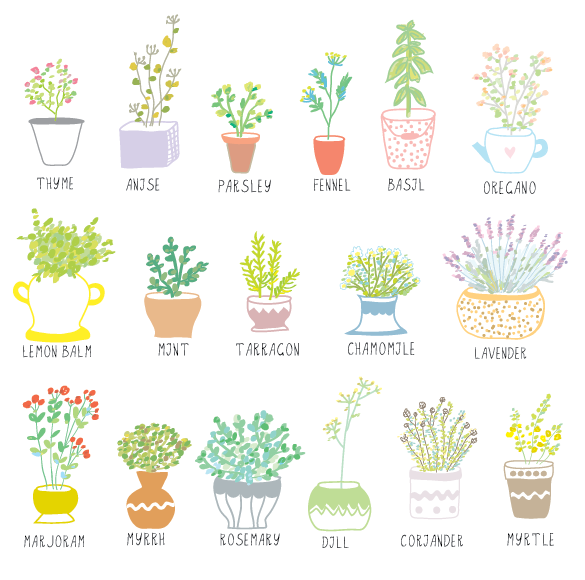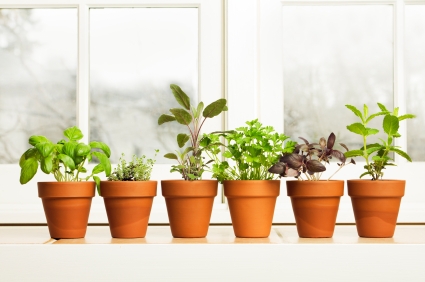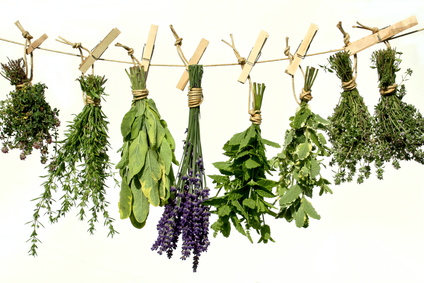Growing Herbs in Arkansas

Herb gardens are as popular as perennial gardens today. We are now growing and using fresh herbs in everything from pesto to potpourri. Below are a few general tips and info on herbs:
- If you are new to growing herbs you may want to start out with some of the easier herbs.
- Annual herbs include basil, dill and cilantro.
- Easy perennials include chives, rosemary and thyme.
- Most herbs do best in a sunny, well-drained location.
Did you know you can contact your local county agent for advice on growing herbs in your county?
Herbs in your Arkansas home landscape
Consider what herbs you want to grow -- what color are they, when do they bloom, how tall do they grow and are they bushy or spreading in growth habit. Then begin to combine them. If you don't want all herbs, mix them in with traditional landscaping. Take some precautions if mixing in with other plants -- avoid pesticide usage near herbs. With herbs, you are eating entire plant parts, and many have fuzzy or crinkled leaves. Don't plant herbs for culinary uses near pesticide-needy plants.
Although herb plants start out small, they begin to grow, and need space to fill in. When deciding on plant spacing, allow room for continued growth, or interplant with annuals, that won't need the space next season.
Visit our edible landscaping page
How many herbs to plant
Deciding how many of each herb you'll need, will depend on how much you will use this herb, and how large the plant will grow. A single mint plant may take care of all of your mint needs and then some, whereas if you use a lot of fresh cilantro in salads and dishes, you'll need to plant several plants to satisfy your needs. If you end up producing too much of one herb, either freeze it or dry it for later use, or share some with a friend.
Harvesting herbs
The beauty lies in the fact that you don't have to wait months to reap your rewards, since you can start harvesting the day you plant. Snip some off the top and keep doing that all season (unless you are going after seeds) and this will keep the plant spreading out, and give you a continuous supply of fresh herbs. The best time to cut fresh herbs is in the morning after the dew dries, yet before mid day heat hits. If you set off for work too early, you haven't missed out, since you can also harvest in the evening after the sun has set.
Cooking and eating herbs
There are lots of magazines and books out there on herbs--with growing techniques as well as recipes and craft ideas. Cooking with fresh herbs is a little different than using them dried, so start gradually adding different amounts. Herbs are supposed to complement your food, not completely mask it. Start drying your own herbs for winter usage, or freeze them. If you end up having too many herbs to deal with all at once, you can put the cut herbs in a damp paper towel inside of a plastic bag in the refrigerator for a few days, or freeze them whole. Taller growing herbs can be used in flower arrangements or in a vase of water for a fresh ‘scent' while waiting to be used. But fresh herbs must be used within a few days or they quickly diminish in quality.
Additional information on specific herbs can be found in Tables 1 and 2.
Table 1. Growing Requirements, Propagation and Uses of Annual Herbs
|
Plant |
Height |
Spacing |
Light |
Propagation |
Uses |
|---|---|---|---|---|---|
|
Anise |
24" |
10" |
Sun |
Grow from seed. |
Leaves in soups, sauces, and salads; oil for flavoring; seeds for seasoning cakes, breads, and cookies. |
|
Basil, sweet |
20 to 24" |
6 to 12" |
Sun |
Grow from seed; grow transplants for early-season harvest. |
Leaves in soups, stews, pasta sauce, poultry and meat dishes; flavors vinegar; teas. |
|
Borage |
1 to 3' |
12" |
Sun |
Grow from seed; self-sowing. |
Edible flower; leaves in salads, teas, and sandwiches; attracts bees. |
|
Calendula (Pot Marigold) |
12" |
12 to 18" |
Sun, partial shade |
Grow from seed. |
Flower petals give color to soups, custards, and rice; cookies; vinegars; crafts. |
|
Caraway |
12 to 24" |
10" |
Sun |
Grow from seed; biennial seed bearer, some cultivars are annual seed bearers. |
Leaves in salads, teas, stews, and soups; seeds for flavoring cookies, breads, salads, and cheeses; roots can be cooked. |
|
Chamomile, sweet false |
1 to 2 ½' |
4 to 6" |
Sun |
Grow from seed. |
Tea, potpourris, garnish, crafts. |
|
Chervil |
1 ½ to 2' |
15" |
Partial shade |
Sow seeds in early spring; needs light to germinate; does not transplant well, not heat tolerant. |
Leaves in salads, soups, and sauces; teas; butters. |
|
Coriander (cilantro) |
24" to 36" |
12 to 18" |
Sun, partial shade |
Grow from seed; goes to seed quickly, so plant frequently. |
Entire plant is edible; leaves in stews and sauces; stems flavor soups and beans; seeds in sauces and meat dishes, potpourris, and sachets. |
|
Dill |
3 to 5' |
3 to 12" |
Sun, partial shade |
Sow seed early spring. |
Teas; seasoning for butter, cakes, bread, vinegars, soups, fish, pickles, salads, etc.; flowers in crafts. |
|
Nasturtium |
15" |
6" |
Sun |
Grow from seed; does not transplant well. |
Leaves, stems, and flowers have a peppery taste; use in salads. |
|
Parsley |
6 to 18" |
6" |
Sun |
Sow seed early spring; slow to germinate; soak in warm water; is a biennial grown as an annual. |
Garnish; flavoring for salads, stews, soups, sauces, and salad dressings. |
|
Perilla |
36" |
3 to 6" |
Sun |
Grow from seed. |
Decorative plant; flavoring oriental dishes. |
|
Summer savory |
12 to 18" |
10 to 12" |
Sun |
Sow seed in early spring, cuttings. |
Mild peppery taste; used with meat, cabbage, rice, and bean dishes, stuffings, teas, butters, vinegars. |
Table 2. Growing Requirements, Propagation and Uses of Biennial and Perennial Herbs
|
Common name/ |
Height |
Spacing |
Light Requirement |
Propagation |
Uses |
|---|---|---|---|---|---|
|
Angelica |
2 to 3' |
3' |
Partial shade |
Grow from seed. |
Stems raw or in salads; leaves in soups and stews; teas; crafts; closely resembles poisonous water hemlock. |
|
Anise hyssop |
3 to 5' |
12 to 24" |
Sun, light shade |
Grow from seed or division. |
Attracts bees; edible flowers; leaves for flavoring or teas; crafts; seeds used in cookies, cakes, and muffins. |
|
Artemisia |
2 to 3' |
24" |
Sun, partial shade |
Division. |
Wreaths and other crafts; aromatic foliage. |
|
Bee balm |
2 to 3' |
12 to 15" |
Sun, partial shade |
Grow from seed or division; invasive rhizomes. |
Attracts bees, butterflies, and hummingbirds; teas; flavors jellies, soups, stews, and fruit salads; edible flowers; dried flowers in crafts. |
|
Burnet, salad |
12" |
18 to 24" |
Sun, well-drained soil |
Grow from seed or division. |
Cucumber-flavored leaves used in salads, vinegar, butter, cottage cheese, and cream cheese; garnish. |
|
Clary sage |
5' |
24" |
Sun |
Grow from seed; biennial. |
Leaves in omelets, fritters, and stews; flavoring of beers and wines; oil. |
|
Chamomile |
2 to 8" |
18" |
Sun, partial shade; well-drained soil |
Grow from seed, division, or stem cuttings. |
Dried flowers for tea; potpourris; herb pillows. |
|
Catnip |
3 to 4' |
12 to 18" |
Sun or shade |
Grow from seed or division. |
Teas; fragrance for cats. |
|
Chives |
12" |
12" |
Sun, partial shade |
Grow from seed or division. |
Edible flowers; leaves for flavoring, eggs, soups, salads, butter, cheese, dips, spreads, etc. |
|
Comfrey |
3 to 5' |
3' |
Sun |
Grow from seed, cuttings, root division. |
Safety of ingestion is highly questionable. Large, rambling plant; dyes, cosmetics. |
|
Costmary |
2 to 4' |
12" |
Sun, light shade |
Division. |
Garnish; fragrance. |
|
Echinacea |
1 to 2' |
18" |
Sun |
Grow from seed or crown division. |
Ornamental plant; used medicinally. |
|
Fennel |
4 to 5' |
4 to 12" |
Sun |
Grow from seeds, difficult to transplant. |
Entire plant edible; seeds in sausage and baked goods; leaves used with fish, vegetables, cheese spreads, and soups. |
|
Feverfew |
2 to 3' |
12" |
Sun, partial shade |
Grow from seed or division. |
Tea, crafts, dyes . |
|
Geranium, scented |
12 to 24" |
12 to 24" |
Sun |
Grow from stem cuttings. |
Teas, potpourris, sachets, jellies, vinegars, desserts. |
|
Germander |
10 to 12" |
8 to 10" |
Sun, partial shade |
Slow to germinate from seed. Stem cuttings, layering, division. |
Attracts bees, decorative plant. |
|
Horehound |
24" |
15" |
Full sun |
Grow from seed, cuttings, or division. |
Attracts bees; tea; flavoring in candy, crafts. |
|
Hyssop |
24" |
15" |
Sun |
Grow from seed, stem cuttings, or division. |
Attracts bees and butterflies; mostly decorative usage, potpourris. |
|
Lavender |
24 to 36" |
18" |
Sun |
Grow from seed or stem cuttingsv |
Potpourris; herb pillows; crafts, vinegars and jellies. |
|
Lemon balm |
3' |
2' |
Sun, light shade |
Grow from seed, stem cuttings, or division. |
Teas; flavors soups, stew, fish, poultry, vegetables, and meat dishes; garnish; potpourris. |
|
Lemon verbena |
2 to 5' |
12 to 24" |
Sun |
Grow from stem cuttings. |
Potpourris; herb pillows; lemon flavoring for drinks, salads, and jellies; teas. |
|
Lovage |
3 to 5' |
2' |
Sun, partial shade |
Sow seeds late summer; division. |
Seeds in breads, butters, and cakes; teas; leaves in soup, stew, cheese, cookies, and chicken dishes; root edible. |
|
Marjoram |
1 to 2' |
12" |
Sun |
Grow from stem cuttings, division, or seed. |
Flavoring for meats, salads, omelets, vinegars; jellies; teas; flower head for crafts. |
|
Oregano |
24" |
8 to 12" |
Sun |
Grow from cuttings or division. |
Flavoring for tomato dishes, meat, poultry and pork stuffings; vegetables and sauces, etc. |
|
Peppermint |
36" |
18" |
Sun, light shade |
Cuttings and division recommended; invasive rhizomes. |
Teas, fragrance. |
|
Rosemary |
3 to 6' |
12" |
Sun |
Seeds slow to germinate; use stem cuttings, layering, or division. |
Teas; flavoring for vinegar, jam, bread, butters, stuffing, vegetables, stew, and meat dishes. |
|
Rue |
3' |
12 to 18" |
Sun |
Grow from seed, stem cuttings, or division. |
Decorative plant. |
|
Sage |
18 to 30' |
12" |
Sun |
Grows slowly from seed; stem cuttings, division, layering. |
Seasoning for meat, vegetable and egg dishes; stuffings. |
|
Sage, pineapple |
2 to 3' |
24" |
Sun |
Stem cuttings. |
Attracts hummingbirds and butterflies; teas; potpourri; cream cheese; jams, jellies. |
|
Santolina |
24" |
2 to 3' |
Sun, needs good drainage |
Slow to germinate from seeds. Stem cuttings, layering, or division. |
Dried arrangements and potpourris; accent plant. |
|
Sorrel |
3 to 4' |
12" |
Sun |
Grow from seed. |
Flavoring of soups, butters, omelets; some species of sorrel are toxic. |
|
Southernwood |
4' |
18" |
Sun, well drained soil |
Stem cuttings, division. |
Teas; sachets; potpourris. |
|
Spearmint |
18" |
18" |
Sun, partial shade |
Cuttings or division recommended; invasive rhizomes. |
Teas; flavors sauces, jellies, and vinegars; leaves in fruit salad, peas, etc. |
|
Sweet marjoram |
8" |
12" |
Sun |
Grow from seed, division, or cuttings . |
Flavors tomato sauces, eggs, etc. Leaves in salads, sauces, pizza, and meats. |
|
Sweet rocket |
3 to 4' |
24" |
Sun |
Grow from seed. |
Salads. |
|
Sweet woodruff |
8" |
12" |
Partial shade |
Division. |
Tea; sachets, dyes. |
|
Tansy |
3 to 4' |
2 to 3' |
Sun |
Grow from seed or division. |
Toxic oil in leaves; decorative plant; crafts. |
|
Tarragon |
24" |
12" |
Sun |
Division or root cuttings, stem cuttings are slow to root . |
Sauces, salads, soups, omelets, meat, vegetable, and fish dishes. |
|
Thyme, common |
4 to 12" |
6 to 12" |
Sun |
Cuttings, seeds, or division. |
Teas; attracts bees; sachets; potpourris; flavoring for poultry, fish, stews, soups, tomatoes, cheese, eggs, and rice. |
|
Valerian |
2 to 5' |
12 to 24" |
Sun |
Division is recommended over seeding. |
Roots for flavoring; ornamental plant. |
|
Yarrow |
8" to 5' |
12" |
Sun |
Seeds or division. |
Crafts. |
|
Winter savory |
24" |
18" |
Sun |
Grow in light, sandy soil from cuttings or seed; cut out dead wood. |
Leaves used to flavor meat, fish, salads, soup, stew, and sausage. |
|
Wormwood |
36" |
12 to 36" |
Sun |
Seed germinate slowly; use stem cuttings or division. |
Bitter flavor; toxic if consumed in large quantity; ornamental plant, dried arrangements; insect repellent. |
To conserve moisture and prevent splashing mud, mulch your garden after planting. Use 1 to 2 inches of organic material. Many growers mulch with hardwood bark or a mixture of bark and sawdust. The use of a landscape fabric covered with mulch has proven to provide excellent weed control and slows down the spread of invasive herbs, such as mints. For Mediterranean herbs, mulch with white "concrete" sand or gravel to provide drainage and light reflection.
When grown outdoors and given ample air circulation, sunlight, and water drainage, herbs rarely suffer severe disease or insect damage. Natural predators and parasites usually keep mite and aphid populations below damaging levels. This is especially true in gardens with a wide diversity of plants. Traditional synthetic pesticides are not labeled for use on culinary herbs, so rely on cultural, biological, and physical control techniques. Insecticidal soap or horticultural oil are useful against severe outbreaks of aphids, mites, and whiteflies. Hand-pick larger pests such as beetles and caterpillars.
Growing a diverse group of herbs can be attractive; they can provide color, fragrance, and interest throughout the season, and they can help keep pest problems to a minimum. You often will find populations of predators and pests co-existing in a balanced situation.

